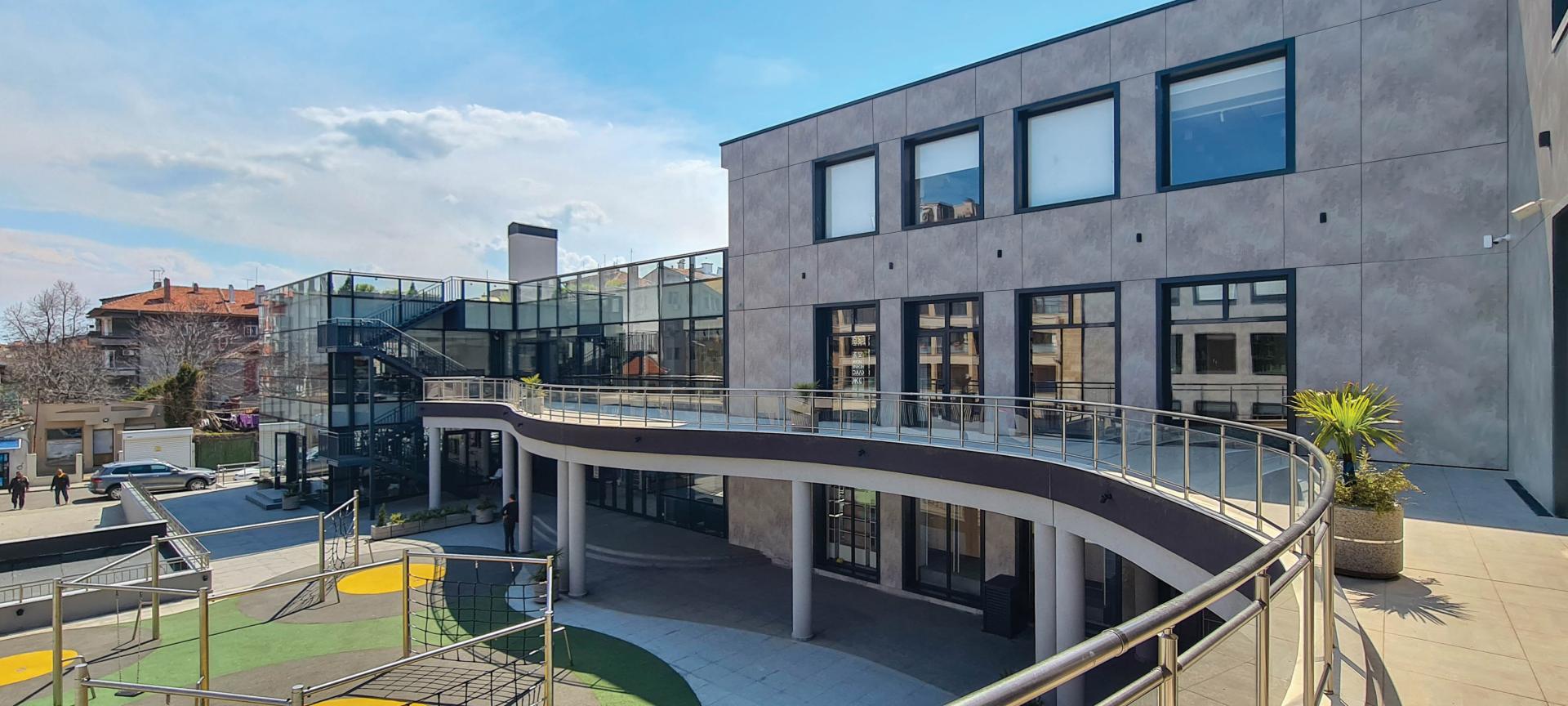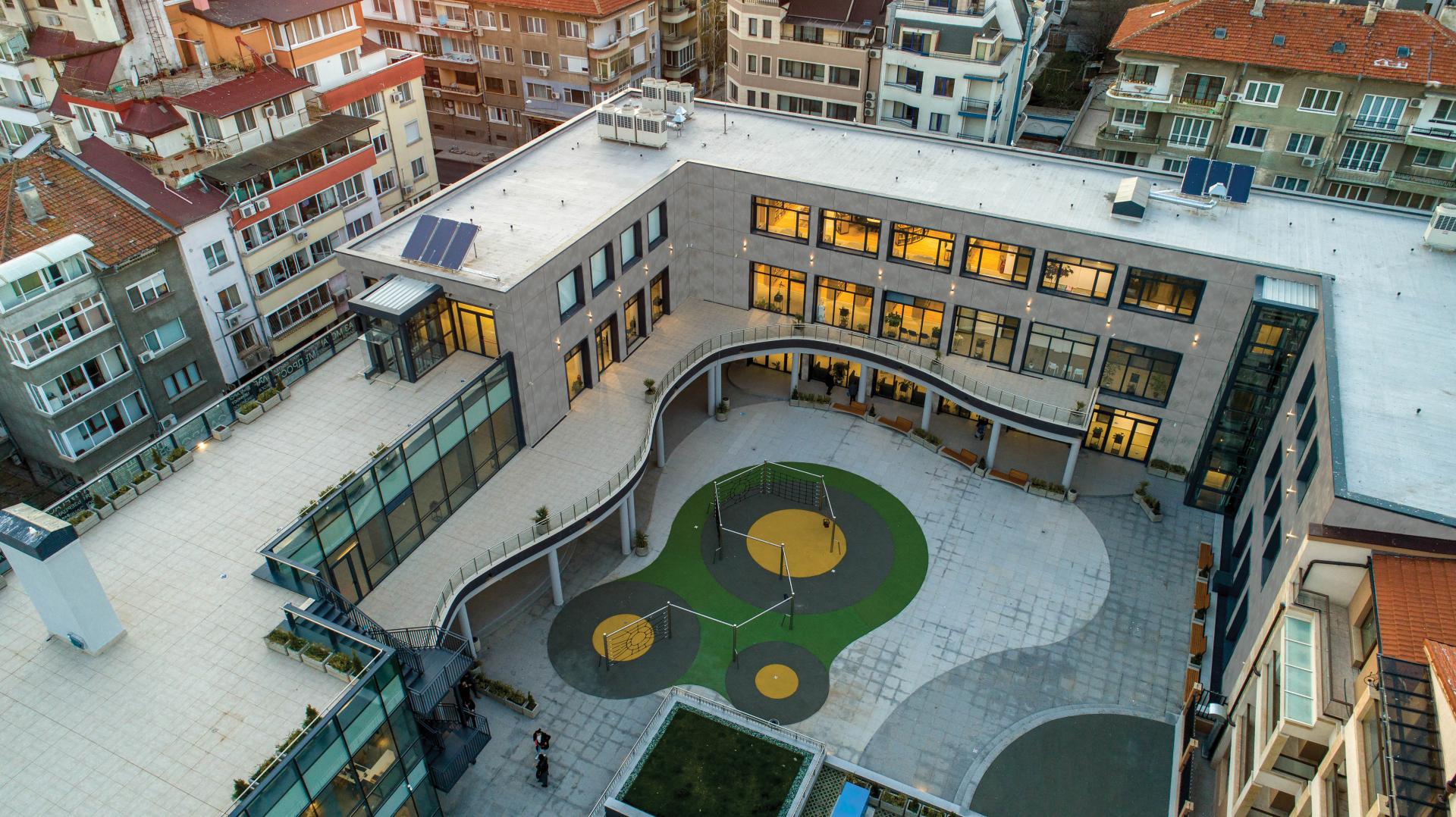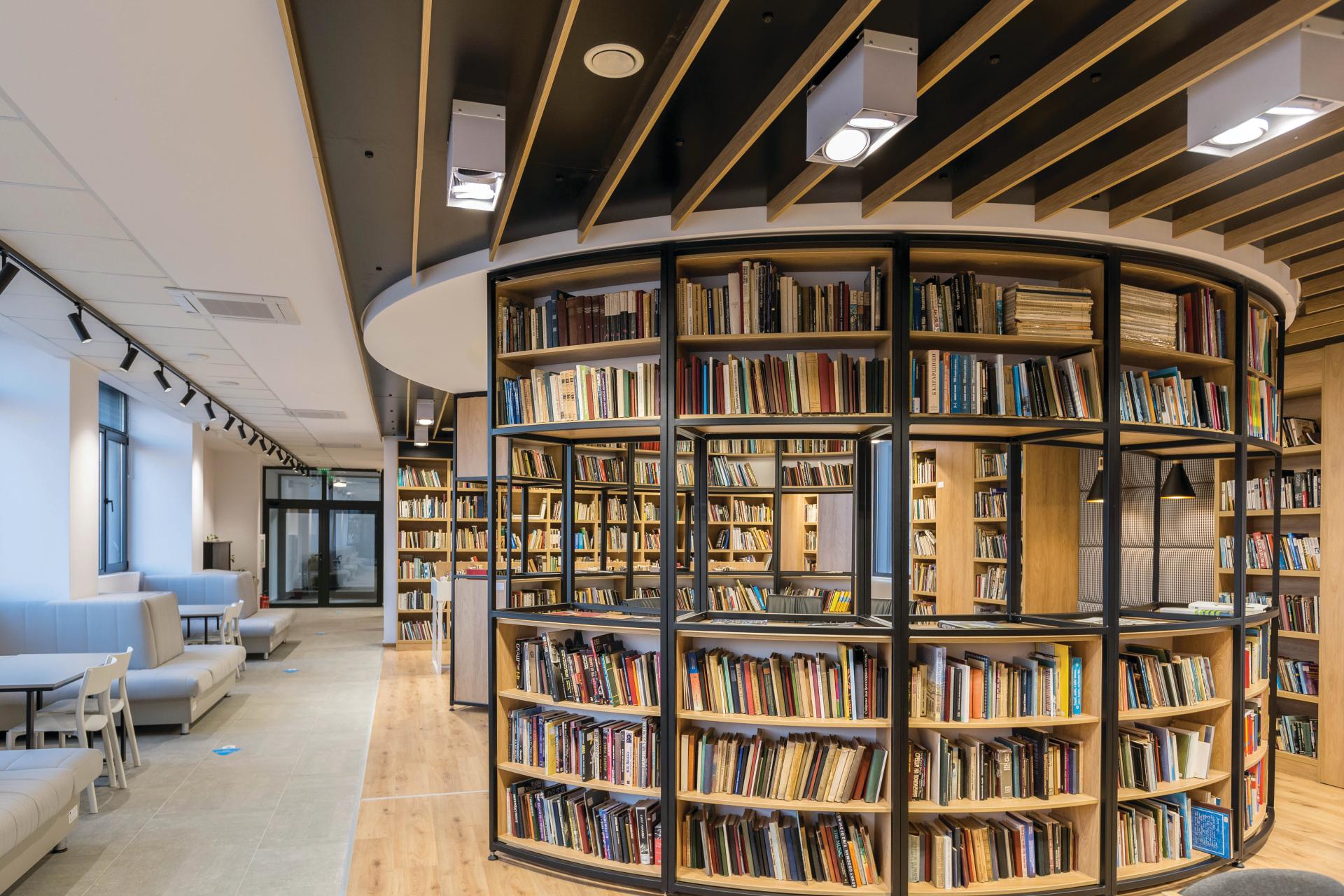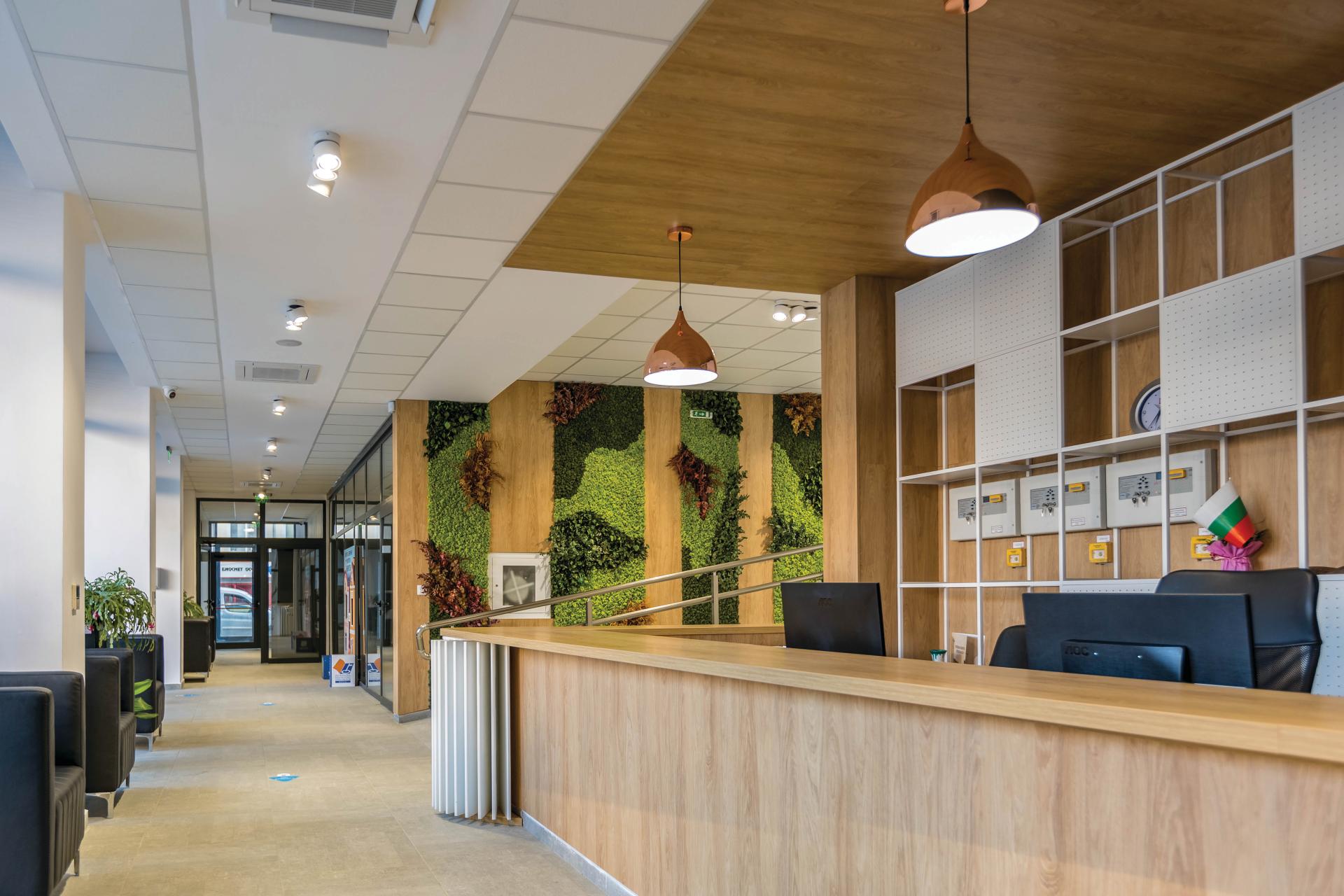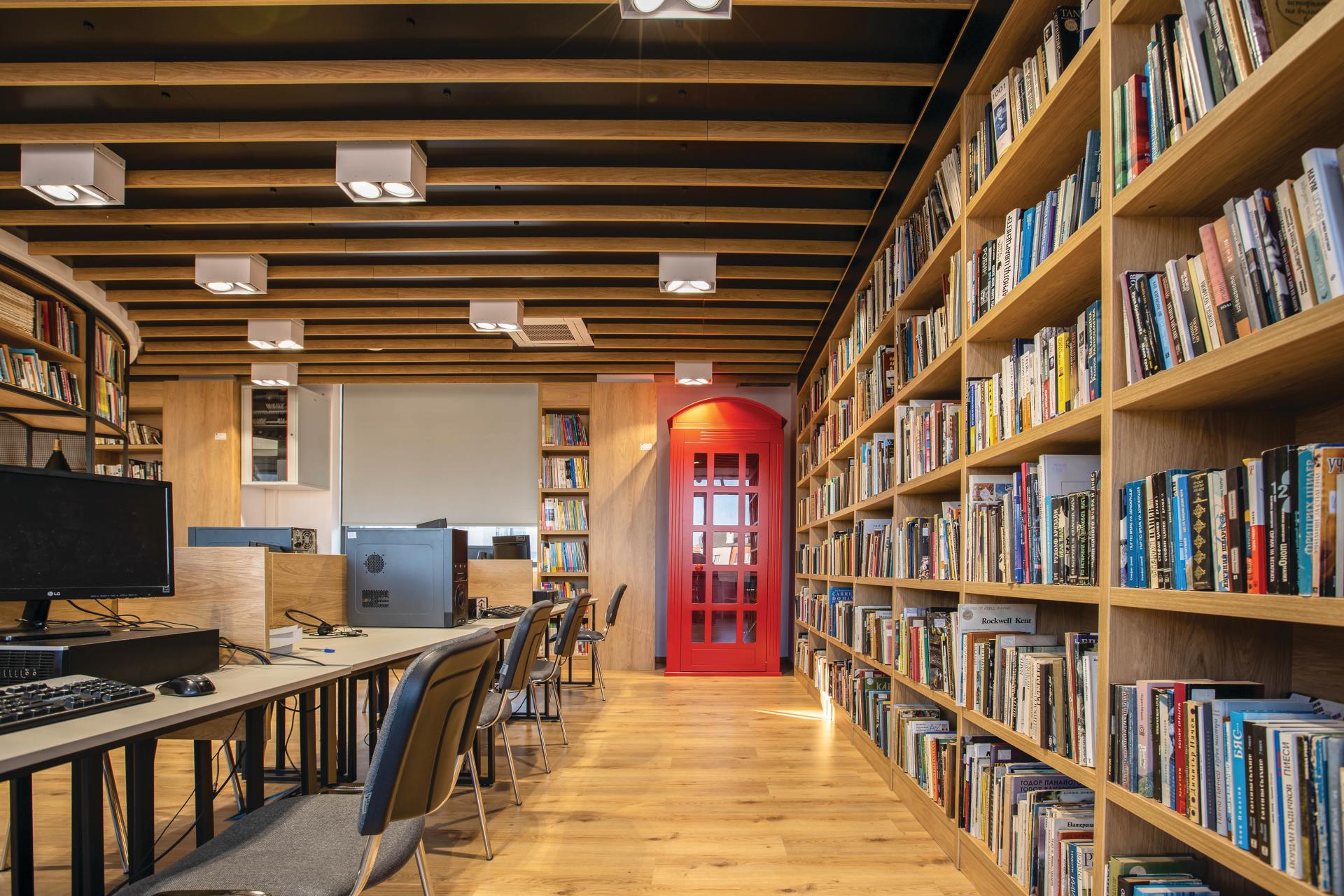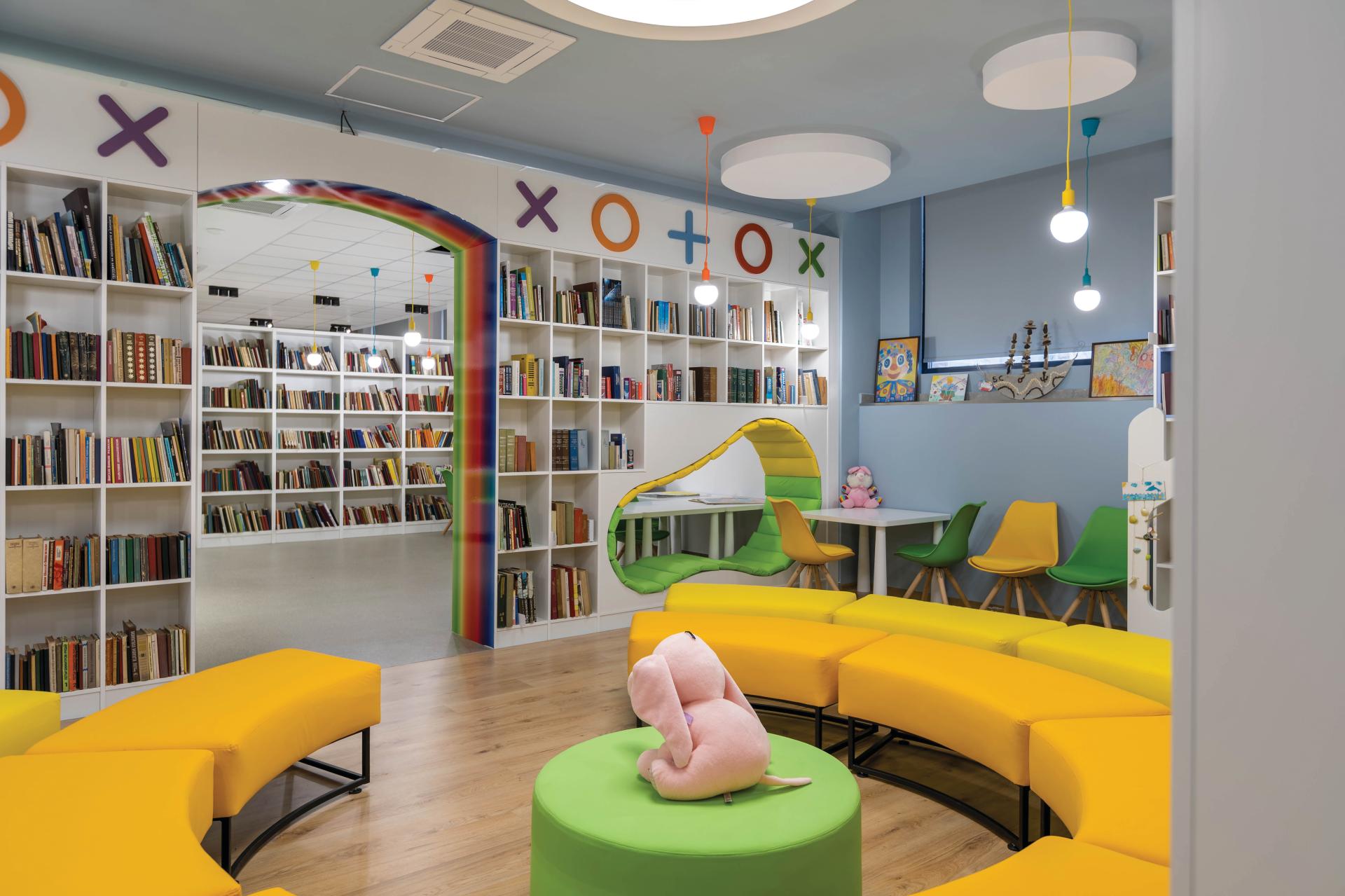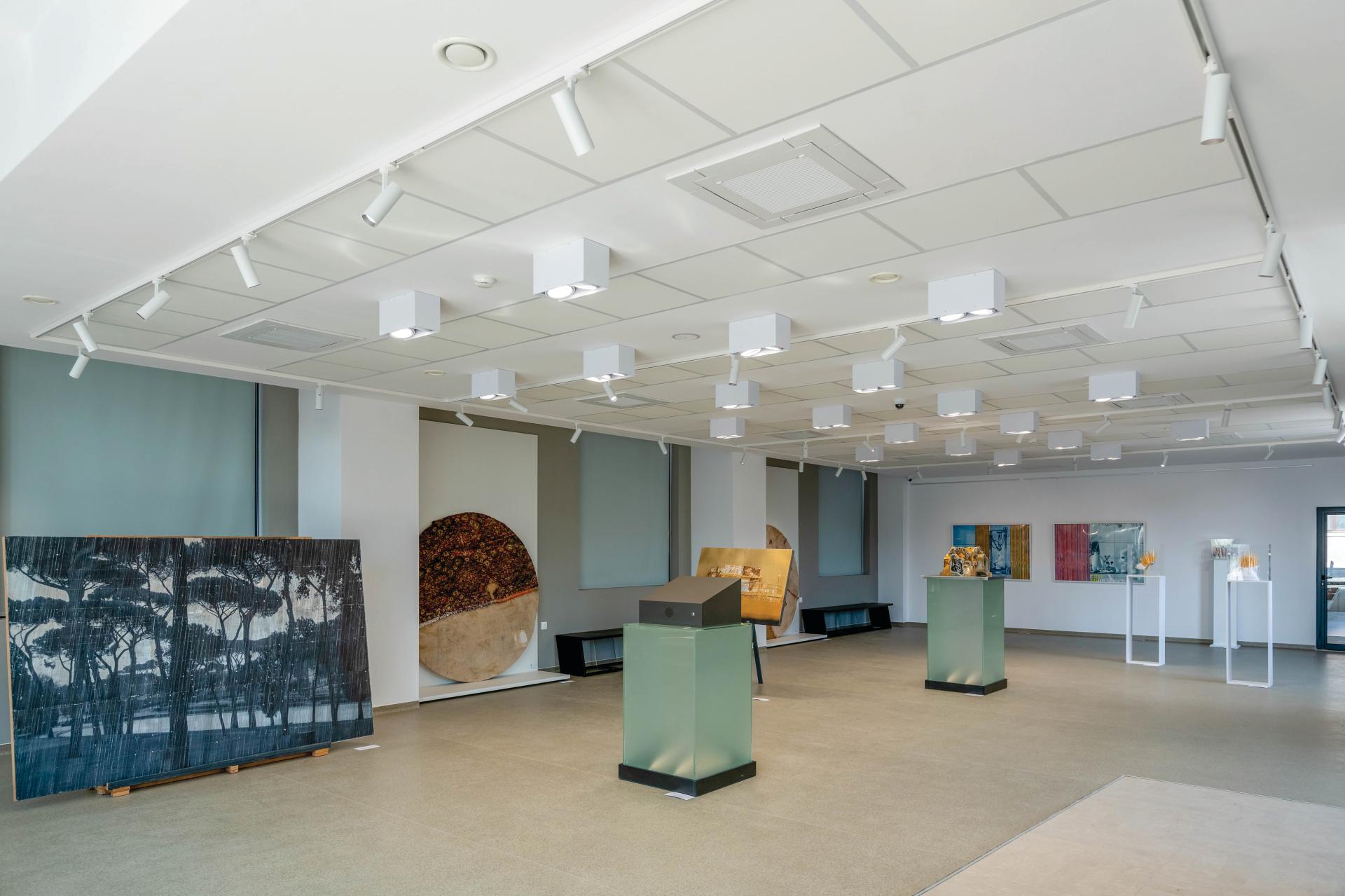Contemporary Art and Library Revival Pro
Basic information
Project Title
Contemporary Art and Library Revival Pro
Full project title
"Reconstruction and reorganization of existing building into a cultural and educational center for c
Category
Regaining a sense of belonging
Project Description
In a remarkable transformation, a long-abandoned building has risen from ruins to become the Burgas Library's cutting-edge, sustainable, and inviting new home. Blending contemporary arts, natural materials, and eco-friendly solutions, it's more than just a library—it's a thriving cultural and educational hub. Our commitment to inclusivity and community involvement sets the stage for vibrant activities.".
Geographical Scope
Local
Project Region
city of Burgas, Bulgaria, Bulgaria
Urban or rural issues
Mainly urban
Physical or other transformations
It refers to a physical transformation of the built environment (hard investment)
EU Programme or fund
Yes
Which funds
ERDF : European Regional Development Fund
Description of the project
Summary
The project was a transformative endeavor initiated by the Burgas Municipality to address pressing challenges raised by local citizens.It set out to modernize and rejuvenate the cultural infrastructure in Burgas Municipality,with a focus on nurturing knowledge, creative innovation,and a sense of shared cultural identity.
The project aimed to meet the cultural needs of the local population by providing access to contemporary cultural initiatives and an upgraded library that catered to individuals with disabilities.
The revitalized cultural infrastructure offered a diverse array of cultural and educational opportunities for tourists.
The project sought to ignite a love for reading and learning among the younger generation through the creation of a modern library.
The initiative was committed to ensuring that disadvantaged community members had equal access to the cultural and educational services offered.
Specific Objectives:
The primary objective was to modernize existing cultural infrastructure to promote local community development.
Accessibility was a key focus,with the aim of providing contemporary educational and cultural services to a broader segment of the population.
The project's vision included offering contemporary cultural initiatives and creating a cutting-edge library.
The establishment of a new Cultural and Educational Center for Contemporary Art was a vital part of the initiative
By addressing the identified challenges,such as inadequate cultural infrastructure, the project successfully created an appealing and accessible Cultural and Educational Center,which in turn nurtured a profound sense of belonging in the community.
The inclusion of facilities catering to people with disabilities within the library extended a warm invitation to all community members,reinforcing a sense of inclusivity and belonging.
Modernized facilities and the addition VR/AR spaces ignited the intellectual curiosity of individuals across different age groups.
The project aimed to meet the cultural needs of the local population by providing access to contemporary cultural initiatives and an upgraded library that catered to individuals with disabilities.
The revitalized cultural infrastructure offered a diverse array of cultural and educational opportunities for tourists.
The project sought to ignite a love for reading and learning among the younger generation through the creation of a modern library.
The initiative was committed to ensuring that disadvantaged community members had equal access to the cultural and educational services offered.
Specific Objectives:
The primary objective was to modernize existing cultural infrastructure to promote local community development.
Accessibility was a key focus,with the aim of providing contemporary educational and cultural services to a broader segment of the population.
The project's vision included offering contemporary cultural initiatives and creating a cutting-edge library.
The establishment of a new Cultural and Educational Center for Contemporary Art was a vital part of the initiative
By addressing the identified challenges,such as inadequate cultural infrastructure, the project successfully created an appealing and accessible Cultural and Educational Center,which in turn nurtured a profound sense of belonging in the community.
The inclusion of facilities catering to people with disabilities within the library extended a warm invitation to all community members,reinforcing a sense of inclusivity and belonging.
Modernized facilities and the addition VR/AR spaces ignited the intellectual curiosity of individuals across different age groups.
Key objectives for sustainability
The project aimed to provide equal access to information and cultural services for all community members, regardless of their ability levels.This objective was achieved through the creation of an accessible and inclusive space.The library building now caters to people with disabilities, reinforcing inclusivity.
The primary objective was to reconstruct a building to house the Regional Library of Burgas.This objective was met by transforming two abandoned buildings,built in 1935 and left vacant since 1990, into a vibrant and sustainable cultural hub.The reconstruction was carried out in a sustainable manner,embracing the principles of a circular economy.Nature-based solutions were applied wherever possible,reducing the project's environmental footprint.
The project incorporated energy-saving lighting, air-conditioning,and ventilation systems,enhancing energy efficiency and reducing the library's carbon footprint. By embracing these technologies,the project supports sustainable development goals,especially those related to clean energy and climate action.
Natural materials and greenery were integrated into the interior design of the library,creating a welcoming and environmentally friendly space.The inclusion of a green moss wall at the entrance further emphasizes the library's commitment to sustainability.
The library actively engages its patrons in circular economy practices.Not only are visitors encouraged to recycle, but the library also hosts regular activities that teach youth about the importance of circularity in the economy.
The library takes a proactive role in promoting environmental awareness.Activities such as an ecological film festival,premieres of films on sustainable architecture, and educational initiatives about the dangers of climate change foster a greater understanding of environmental challenges and the need for urgent adaptation.
The project successfully integrated new technology to engage and educate visitors about biodiversity.
The primary objective was to reconstruct a building to house the Regional Library of Burgas.This objective was met by transforming two abandoned buildings,built in 1935 and left vacant since 1990, into a vibrant and sustainable cultural hub.The reconstruction was carried out in a sustainable manner,embracing the principles of a circular economy.Nature-based solutions were applied wherever possible,reducing the project's environmental footprint.
The project incorporated energy-saving lighting, air-conditioning,and ventilation systems,enhancing energy efficiency and reducing the library's carbon footprint. By embracing these technologies,the project supports sustainable development goals,especially those related to clean energy and climate action.
Natural materials and greenery were integrated into the interior design of the library,creating a welcoming and environmentally friendly space.The inclusion of a green moss wall at the entrance further emphasizes the library's commitment to sustainability.
The library actively engages its patrons in circular economy practices.Not only are visitors encouraged to recycle, but the library also hosts regular activities that teach youth about the importance of circularity in the economy.
The library takes a proactive role in promoting environmental awareness.Activities such as an ecological film festival,premieres of films on sustainable architecture, and educational initiatives about the dangers of climate change foster a greater understanding of environmental challenges and the need for urgent adaptation.
The project successfully integrated new technology to engage and educate visitors about biodiversity.
Key objectives for aesthetics and quality
The project placed significant emphasis on aesthetics and the quality of the cultural and educational experience it provides to people. Its objectives in these aspects have been met in ways that make it exemplary: The transformed abandoned building into an attractive and inviting space was successfully achieved by combining modern design elements with the incorporation of natural materials and greenery.
The cultural experience for all members of the community was elevated. The modernization of the Library allowed it to expand its functions and services and now to offer a diverse range of cultural initiatives, providing a rich and culturally enriching experience for patrons.
By introducing innovative technology, the project has created engaging learning environments that enhance the quality of the educational experience.
The project actively encourages artistic expression and creativity. Regular activities that involve creating art and crafts from discarded objects teach youth about the importance of circularity in the economy.
Ensuring that everyone can access and engage with cultural and educational resources fosters a sense of belonging and enriches the overall experience for all members of the community.
This project stands out as an exemplary model in terms of aesthetics and the quality of the cultural and educational experience it offers.
Inclusivity and accessibility ensure that the quality of the experience is not limited to a select few but is accessible to everyone.
This project is a prime example of how aesthetics and the quality of the cultural and educational experience can be achieved. The new space is not only visually pleasing but also culturally enriching, educational, and inclusive, setting a high standard for the role cultural institutions can play in enhancing the quality of life and experiences within a community.
The cultural experience for all members of the community was elevated. The modernization of the Library allowed it to expand its functions and services and now to offer a diverse range of cultural initiatives, providing a rich and culturally enriching experience for patrons.
By introducing innovative technology, the project has created engaging learning environments that enhance the quality of the educational experience.
The project actively encourages artistic expression and creativity. Regular activities that involve creating art and crafts from discarded objects teach youth about the importance of circularity in the economy.
Ensuring that everyone can access and engage with cultural and educational resources fosters a sense of belonging and enriches the overall experience for all members of the community.
This project stands out as an exemplary model in terms of aesthetics and the quality of the cultural and educational experience it offers.
Inclusivity and accessibility ensure that the quality of the experience is not limited to a select few but is accessible to everyone.
This project is a prime example of how aesthetics and the quality of the cultural and educational experience can be achieved. The new space is not only visually pleasing but also culturally enriching, educational, and inclusive, setting a high standard for the role cultural institutions can play in enhancing the quality of life and experiences within a community.
Key objectives for inclusion
A core objective of the project was to provide equal access to information and cultural services for all community members, regardless of their abilities. The reconstruction of the library building considered accessibility for individuals with disabilities. It includes features like ramps, elevators, and spaces designed to accommodate those with mobility challenges.
The project offers a wide range of services and activities that are accessible at little to no cost, making culture and education affordable and within reach for the entire community.
The project actively involves the community in the planning and organization of activities. It fosters inclusive governing systems by seeking input and feedback from a diverse range of stakeholders, ensuring that the community's needs and preferences are considered. This approach promotes a sense of ownership and belonging.
In the reconstruction and modernization of the library, the project adhered to "design for all" principles. This means that the spaces and facilities are designed to accommodate a broad spectrum of users, regardless of age, ability, or background. The design ensures that everyone can fully engage with and enjoy the services provided.
The project, through its emphasis on sustainability, circular economy practices, and the promotion of environmental awareness, sets the stage for new societal models. It challenges traditional models and promotes a more inclusive and sustainable approach to culture, education, and community engagement.
The project has successfully integrated accessibility features, ensuring that individuals with disabilities can fully participate in cultural and educational activities.
The "design for all" principles followed in the reconstruction promote universal access and engagement.
The project offers a wide range of services and activities that are accessible at little to no cost, making culture and education affordable and within reach for the entire community.
The project actively involves the community in the planning and organization of activities. It fosters inclusive governing systems by seeking input and feedback from a diverse range of stakeholders, ensuring that the community's needs and preferences are considered. This approach promotes a sense of ownership and belonging.
In the reconstruction and modernization of the library, the project adhered to "design for all" principles. This means that the spaces and facilities are designed to accommodate a broad spectrum of users, regardless of age, ability, or background. The design ensures that everyone can fully engage with and enjoy the services provided.
The project, through its emphasis on sustainability, circular economy practices, and the promotion of environmental awareness, sets the stage for new societal models. It challenges traditional models and promotes a more inclusive and sustainable approach to culture, education, and community engagement.
The project has successfully integrated accessibility features, ensuring that individuals with disabilities can fully participate in cultural and educational activities.
The "design for all" principles followed in the reconstruction promote universal access and engagement.
Results in relation to category
1.Transformation of Dilapidated Site: The project successfully transformed a previously dilapidated site into a modern, aesthetically pleasing building with a total area of 6036 sq.m. The creation of an adjacent yard space, featuring a children's playground and an art exhibition area, further enhanced the site's appeal.
2.New Home for Burgas Regional Library: The newly reconstructed building serves as the new home for the Burgas Regional Library, providing various spaces and facilities. It includes separate book storage halls housing more than 600,000 library units, a dedicated children's library and creativity area, an information center, and reading and book lending halls.
3.Center for Contemporary Art: The project also established the Center for Contemporary Art in Burgas, equipped with two meeting and exposition venues, co-working and educational spaces, art labs, a book store, and a café.
4.High-Technology Equipment: The project delivered high-technology equipment for educational purposes, including a 3D printer and STEM innovations such as VR/AR technology. The addition of interactive systems and state-of-the-art library equipment ensures a seamless and innovative experience for visitors.
5.Improved Cultural Infrastructure: The project led to a substantial improvement in the city's cultural infrastructure.
6.Increased Membership and Visits: The project's impact is evident in the significant increase in library membership and visits. The library gained over 26,000 new members and received more than 265,000 visits since the project's inception in 2019.
7.24/7 Accessibility: The library's accessibility 24 hours a day creates a vital space for self-development and socialization, particularly for youth.
8.Cultural Enrichment of the City: In just two years after the project's completion, the Library and Arts Center have had a noticeable impact on the city expressed in increased city's cultural potential, providing diverse cultural offerings for citizens.
2.New Home for Burgas Regional Library: The newly reconstructed building serves as the new home for the Burgas Regional Library, providing various spaces and facilities. It includes separate book storage halls housing more than 600,000 library units, a dedicated children's library and creativity area, an information center, and reading and book lending halls.
3.Center for Contemporary Art: The project also established the Center for Contemporary Art in Burgas, equipped with two meeting and exposition venues, co-working and educational spaces, art labs, a book store, and a café.
4.High-Technology Equipment: The project delivered high-technology equipment for educational purposes, including a 3D printer and STEM innovations such as VR/AR technology. The addition of interactive systems and state-of-the-art library equipment ensures a seamless and innovative experience for visitors.
5.Improved Cultural Infrastructure: The project led to a substantial improvement in the city's cultural infrastructure.
6.Increased Membership and Visits: The project's impact is evident in the significant increase in library membership and visits. The library gained over 26,000 new members and received more than 265,000 visits since the project's inception in 2019.
7.24/7 Accessibility: The library's accessibility 24 hours a day creates a vital space for self-development and socialization, particularly for youth.
8.Cultural Enrichment of the City: In just two years after the project's completion, the Library and Arts Center have had a noticeable impact on the city expressed in increased city's cultural potential, providing diverse cultural offerings for citizens.
How Citizens benefit
Citizens and civil society have played a crucial role in the project from its inception, and their involvement has had a profound impact on the project's success and outcomes.
From the very beginning, Burgas Municipality engaged a wide cross-section of stakeholders and citizens to determine the priority areas and projects for the Integrated Plan for the Rehabilitation and Development of the city .This process ensured that the project aligned with the community's actual needs and desires, demonstrating a high level of involvement.
Citizens were given a choice regarding the future use of the intervention site, and an overwhelming majority chose to establish the Regional Library and the Center for Contemporary Art. Members of the public were actively consulted and involved in the creation of the overall architectural concept and interior design of the building. Their input contributed to the project's aesthetics and functionality, reflecting a collaborative approach to design and cultural development.
The involvement of citizens and civil society has had a significant impact on the project's development and its outcomes:
The active participation of the local community in decision-making and project planning has fostered a sense of ownership. The building and its facilities have been recognized as belonging to the citizens, leading to a strong sense of pride and connection among the community.
The high level of community involvement has resulted in a substantial increase in library membership, readership, and visitor numbers.
The project's impact is seen in the increased accessibility of library resources. The substantial growth in the number of library documents distributed to users reflects a higher demand for educational and cultural materials.
The involvement of citizens has contributed to the project's success in promoting cultural vibrancy.The project is no longer just a physical space but a dynamic hub for cultural and educational activities.
From the very beginning, Burgas Municipality engaged a wide cross-section of stakeholders and citizens to determine the priority areas and projects for the Integrated Plan for the Rehabilitation and Development of the city .This process ensured that the project aligned with the community's actual needs and desires, demonstrating a high level of involvement.
Citizens were given a choice regarding the future use of the intervention site, and an overwhelming majority chose to establish the Regional Library and the Center for Contemporary Art. Members of the public were actively consulted and involved in the creation of the overall architectural concept and interior design of the building. Their input contributed to the project's aesthetics and functionality, reflecting a collaborative approach to design and cultural development.
The involvement of citizens and civil society has had a significant impact on the project's development and its outcomes:
The active participation of the local community in decision-making and project planning has fostered a sense of ownership. The building and its facilities have been recognized as belonging to the citizens, leading to a strong sense of pride and connection among the community.
The high level of community involvement has resulted in a substantial increase in library membership, readership, and visitor numbers.
The project's impact is seen in the increased accessibility of library resources. The substantial growth in the number of library documents distributed to users reflects a higher demand for educational and cultural materials.
The involvement of citizens has contributed to the project's success in promoting cultural vibrancy.The project is no longer just a physical space but a dynamic hub for cultural and educational activities.
Physical or other transformations
It refers to a physical transformation of the built environment (hard investment)
Innovative character
Combination of Cultural and Educational Center with Library: The most notable innovation is the project's unique concept of combining a cultural and educational center for contemporary art with a library in a single facility. This innovative approach allows for the convergence of cultural and educational services under one roof, offering modern educational services, information, and technology access to a diverse audience. This integration creates a new center of urban life, addressing the needs of both residents and disadvantaged groups.
Environmental Sustainability: The project emphasizes sustainability by utilizing innovative environmental materials and alternative sources of energy generation. The building incorporates green technologies and sustainable practices, making it an environmentally responsible addition to the urban landscape.
Architectural and Aesthetic Innovation: The architectural design breaks away from traditional facades and introduces a state-of-the-art volumetric solution that not only modernizes the existing structure but also establishes a distinctive and recognizable identity for the building.
Inclusive and Innovative Infrastructure: The project prioritizes inclusivity by providing modern, environmentally friendly, and adaptable furniture that caters to the needs of a diverse user base, including children, youths, and adults. Additionally, the incorporation of innovative technologies, such as STEM innovations and VR/AR-based learning, sets it apart in the realm of educational and cultural centers.
Holistic Approach: The project's holistic approach to creating a space that serves multiple functions, promotes culture and education, and supports sustainability sets it apart from more conventional projects.
Investment in Quality Infrastructure: The project's commitment to quality and reliability, both in terms of architectural design and equipment, is a departure from mainstream actions.
Environmental Sustainability: The project emphasizes sustainability by utilizing innovative environmental materials and alternative sources of energy generation. The building incorporates green technologies and sustainable practices, making it an environmentally responsible addition to the urban landscape.
Architectural and Aesthetic Innovation: The architectural design breaks away from traditional facades and introduces a state-of-the-art volumetric solution that not only modernizes the existing structure but also establishes a distinctive and recognizable identity for the building.
Inclusive and Innovative Infrastructure: The project prioritizes inclusivity by providing modern, environmentally friendly, and adaptable furniture that caters to the needs of a diverse user base, including children, youths, and adults. Additionally, the incorporation of innovative technologies, such as STEM innovations and VR/AR-based learning, sets it apart in the realm of educational and cultural centers.
Holistic Approach: The project's holistic approach to creating a space that serves multiple functions, promotes culture and education, and supports sustainability sets it apart from more conventional projects.
Investment in Quality Infrastructure: The project's commitment to quality and reliability, both in terms of architectural design and equipment, is a departure from mainstream actions.
Disciplines/knowledge reflected
The design and implementation of the project drew from a wide range of disciplines and knowledge fields, involving experts from diverse backgrounds:
Architects were instrumental in the overall design and structural planning of the new building.Their expertise was crucial in creating an aesthetically pleasing and functional space
Interior designers focus on aesthetics,functionality, and user experience contributed to the project's welcoming and inclusive environment.
Civil engineers provided the technical knowledge and expertise required for the construction of the building. They ensured that the structure was safe,sound,and met all regulatory standards.
The involvement of artists extended beyond aesthetics. They played a key role in creating the writing that covers the glass façade,adding an artistic and cultural dimension to the building's exterior.
Library staff brought their expertise in library services and the needs of library usersTheir input was invaluable in designing the library's layout,resources, and services.Municipal experts contributed their local knowledge and insights into the specific needs and dynamics of the Burgas community,aligning the project with the municipality's objectives.As overseers of the project, the Ministry of Regional Development provided their expertise in project management,oversight, and compliance with regional development policies.
Educators from138 educational institutions offered their insights on creating a space that is not only educational but also innovative and engaging for students.Social Workers and Child Psychologists played a role in making the space inclusive and welcoming,especially for more vulnerable groups such as children and people with disabilities.Their knowledge contributed to the design of spaces that catered to specific social and psychological needs.Environmental experts were consulted to incorporate sustainable and eco-friendly features into the design, aligning the project with sustainable goals
Architects were instrumental in the overall design and structural planning of the new building.Their expertise was crucial in creating an aesthetically pleasing and functional space
Interior designers focus on aesthetics,functionality, and user experience contributed to the project's welcoming and inclusive environment.
Civil engineers provided the technical knowledge and expertise required for the construction of the building. They ensured that the structure was safe,sound,and met all regulatory standards.
The involvement of artists extended beyond aesthetics. They played a key role in creating the writing that covers the glass façade,adding an artistic and cultural dimension to the building's exterior.
Library staff brought their expertise in library services and the needs of library usersTheir input was invaluable in designing the library's layout,resources, and services.Municipal experts contributed their local knowledge and insights into the specific needs and dynamics of the Burgas community,aligning the project with the municipality's objectives.As overseers of the project, the Ministry of Regional Development provided their expertise in project management,oversight, and compliance with regional development policies.
Educators from138 educational institutions offered their insights on creating a space that is not only educational but also innovative and engaging for students.Social Workers and Child Psychologists played a role in making the space inclusive and welcoming,especially for more vulnerable groups such as children and people with disabilities.Their knowledge contributed to the design of spaces that catered to specific social and psychological needs.Environmental experts were consulted to incorporate sustainable and eco-friendly features into the design, aligning the project with sustainable goals
Methodology used
The project followed a comprehensive and integrated methodology with a focus on sustainable development encompassing economic, social, and ecological dimensions.1.Economic Perspective:•Competitiveness: The project aimed to increase the city's competitiveness by developing accessible and innovative cultural infrastructure.This improved cultural offering aligned with the city's vision as a preferred place to live, work, and entertain. •Tourism and High-Value Sectors: As the city aspired to become a tourist destination and promote sectors with high added value, the development of modern contemporary art and educational activities was identified as a pivotal factor for economic growth. 2. Social Aspect:•Quality of Life: The project's social dimension focused on enhancing the quality of life for the city's residents. It aimed to create conditions for a fulfilling life by improving access to public, cultural, educational, and recreational services for various population groups and city guests.
•Social Inclusion:The project promoted social inclusion by ensuring that the new infrastructure was accessible to diverse groups. •Social Inclusion:The project promoted social inclusion by ensuring that the new infrastructure was accessible to diverse groups.
3. Ecological Aspect:•Environmental Sustainability:The ecological aspect was integral to the project's methodology.Activities related to the reconstruction and remodeling of the existing building were designed to have a positive impact on the environment by reducing the carbon footprint.•Energy Efficiency:The project addressed energy efficiency by implementing a central system with Variable Refrigerant Flow (VRF) units and direct evaporation air conditioners for heating and cooling.•Waste Management:To promote ecological thinking, the project included separate waste collection bins throughout the building. •Reducing Plastic Use:troduced devices for 5-level purification of drinking water to reduce plastic usage by visitor
•Social Inclusion:The project promoted social inclusion by ensuring that the new infrastructure was accessible to diverse groups. •Social Inclusion:The project promoted social inclusion by ensuring that the new infrastructure was accessible to diverse groups.
3. Ecological Aspect:•Environmental Sustainability:The ecological aspect was integral to the project's methodology.Activities related to the reconstruction and remodeling of the existing building were designed to have a positive impact on the environment by reducing the carbon footprint.•Energy Efficiency:The project addressed energy efficiency by implementing a central system with Variable Refrigerant Flow (VRF) units and direct evaporation air conditioners for heating and cooling.•Waste Management:To promote ecological thinking, the project included separate waste collection bins throughout the building. •Reducing Plastic Use:troduced devices for 5-level purification of drinking water to reduce plastic usage by visitor
How stakeholders are engaged
The project has successfully engaged a diverse range of stakeholders at various levels.
The primary beneficiaries of the project, citizens, and visitors of Burgas Municipality were actively involved in shaping the project through consultations and decision-making. Their involvement ensured that the project aligned with the community's cultural and educational needs.
The project catered to the younger generation by offering a modern library that promotes reading and learning. Children and young people were not only beneficiaries but also played a role in
Ensuring equal access to services was a priority. Disadvantaged individuals were involved in the project to ensure that their needs were considered and met.
Artists and authors had the opportunity to display and premiere their works at the library. Their involvement added cultural richness to the project.
The project provided state-of-the-art technological facilities for innovative classes. Educators were directly involved in utilizing these resources to enhance teaching and learning.
Students at the National Academy of Arts branch in Burgas and local high schools specializing in arts were involved, benefiting from the project's cultural and educational resources. Their participation contributed to a dynamic and creative learning environment.
These stakeholders played a unique role during the process of moving the library's book stocks to the new space. Their involvement not only facilitated the physical relocation but also brought significant visibility to the project.
These stakeholders played a unique role during the process of moving the library's book stocks to the new space. Their involvement not only facilitated the physical relocation but also brought significant visibility to the project.
The participation of prominent citizens and artists during the book relocation process added significant visibility and prestige to the project, making it a community-wide endeavor.
The primary beneficiaries of the project, citizens, and visitors of Burgas Municipality were actively involved in shaping the project through consultations and decision-making. Their involvement ensured that the project aligned with the community's cultural and educational needs.
The project catered to the younger generation by offering a modern library that promotes reading and learning. Children and young people were not only beneficiaries but also played a role in
Ensuring equal access to services was a priority. Disadvantaged individuals were involved in the project to ensure that their needs were considered and met.
Artists and authors had the opportunity to display and premiere their works at the library. Their involvement added cultural richness to the project.
The project provided state-of-the-art technological facilities for innovative classes. Educators were directly involved in utilizing these resources to enhance teaching and learning.
Students at the National Academy of Arts branch in Burgas and local high schools specializing in arts were involved, benefiting from the project's cultural and educational resources. Their participation contributed to a dynamic and creative learning environment.
These stakeholders played a unique role during the process of moving the library's book stocks to the new space. Their involvement not only facilitated the physical relocation but also brought significant visibility to the project.
These stakeholders played a unique role during the process of moving the library's book stocks to the new space. Their involvement not only facilitated the physical relocation but also brought significant visibility to the project.
The participation of prominent citizens and artists during the book relocation process added significant visibility and prestige to the project, making it a community-wide endeavor.
Global challenges
Equitable Access to Culture:The project addresses the global challenge of unequal access to cultural infrastructure and activities.Many regions worldwide face disparities in cultural accessibility due to physical and financial barriers.This project demonstrates a local solution by creating an inclusive and accessible cultural and educational center.It bridges social gaps and promotes equitable access to cultural events and library services, encouraging dialogue among diverse cultures, disciplines, genders, and age groups.Financial Inclusion:The project promotes financial inclusion by offering free access to cultural and art events, as well as affordable library services with a minimal annual fee for new readers.Community Empowerment:The project empowers economically inactive populations by providing opportunities for intellectual and creative development, professional knowledge enhancement, and cultural engagement.It contributes to the global challenge of improving the quality of life and career prospects, aligning with the sustainable development principle of community well-being.Environmental Sustainability:The project aligns with global environmental challenges, particularly in the context of the European Green Deal.It reduces greenhouse gas emissions and promotes energy efficiency through the integration of low-energy consumption systems and renewable solar energy equipment.Additionally, it fosters environmentally responsible behavior by encouraging recycling, reducing plastic use, and using nature-based materials in interior design.
Social Inclusion:The project addresses the global challenge of social inclusion by creating a space that welcomes and includes all members of the community in cultural life. It promotes a sense of belonging and social cohesion -crucial for addressing issues related to social inequality and exclusion at the local level.Cultural Preservation and Innovation: Solve the global challenge of balancing cultural preservation with innovation
Social Inclusion:The project addresses the global challenge of social inclusion by creating a space that welcomes and includes all members of the community in cultural life. It promotes a sense of belonging and social cohesion -crucial for addressing issues related to social inequality and exclusion at the local level.Cultural Preservation and Innovation: Solve the global challenge of balancing cultural preservation with innovation
Learning transferred to other parties
Integrated Cultural and Educational Center: The core concept of combining a cultural and educational center for contemporary art with a library is highly replicable. This approach can be adapted and implemented in other cities and regions, catering to diverse groups of beneficiaries, such as students, artists, educators, and the general public
Sustainable Building Practices: The project's focus on sustainability and eco-friendly building practices can serve as a model for future construction projects.
Innovative Educational Technology: The incorporation of innovative educational technology, including VR/AR-based learning and interactive digital equipment, can be replicated in educational institutions and cultural centers. This technology enhances learning experiences and engagement, making it applicable to a wide range of contexts and beneficiaries.
Inclusive Design: The inclusive design of the building's infrastructure, furniture, and layout can be transferred to other public spaces.
Community Engagement: The project's approach to involving citizens, stakeholders, and the public in decision-making processes and design choices can serve as a model for engaging communities in the development of public spaces. This participatory approach can be replicated in various contexts to ensure that projects meet the specific needs and aspirations of the local population.
Cultural Preservation and Development: The project's emphasis on modernizing and rehabilitating cultural infrastructure can be replicated in places where there is a need to preserve and develop cultural potential. This approach can support the revitalization of cultural institutions and heritage sites in various contexts.
Environmental Awareness Initiatives: Initiatives that promote environmental awareness, such as separate waste collection, reducing plastic use, and water purification stations, can be implemented in public and community spaces to encourage eco-friendly practices and sustainability.
Sustainable Building Practices: The project's focus on sustainability and eco-friendly building practices can serve as a model for future construction projects.
Innovative Educational Technology: The incorporation of innovative educational technology, including VR/AR-based learning and interactive digital equipment, can be replicated in educational institutions and cultural centers. This technology enhances learning experiences and engagement, making it applicable to a wide range of contexts and beneficiaries.
Inclusive Design: The inclusive design of the building's infrastructure, furniture, and layout can be transferred to other public spaces.
Community Engagement: The project's approach to involving citizens, stakeholders, and the public in decision-making processes and design choices can serve as a model for engaging communities in the development of public spaces. This participatory approach can be replicated in various contexts to ensure that projects meet the specific needs and aspirations of the local population.
Cultural Preservation and Development: The project's emphasis on modernizing and rehabilitating cultural infrastructure can be replicated in places where there is a need to preserve and develop cultural potential. This approach can support the revitalization of cultural institutions and heritage sites in various contexts.
Environmental Awareness Initiatives: Initiatives that promote environmental awareness, such as separate waste collection, reducing plastic use, and water purification stations, can be implemented in public and community spaces to encourage eco-friendly practices and sustainability.
Keywords
New Home for Burgas Regional Library:
Center for Contemporary Art
Equitable Access to Culture:
Community Empowerment and inclusion
Cultural Preservation and Innovation:

